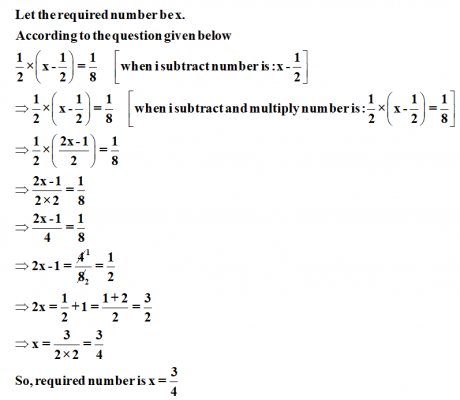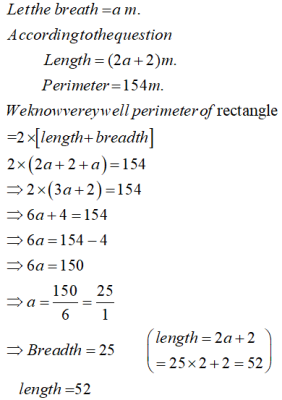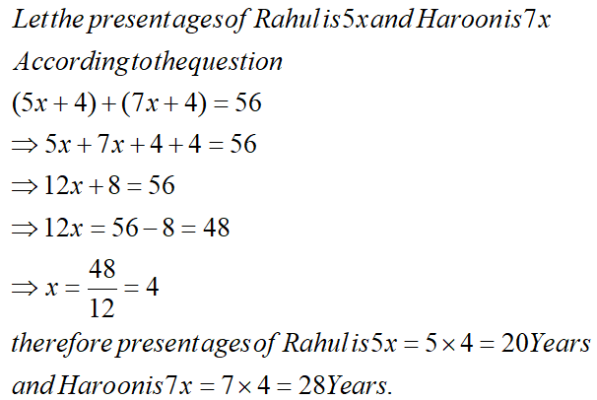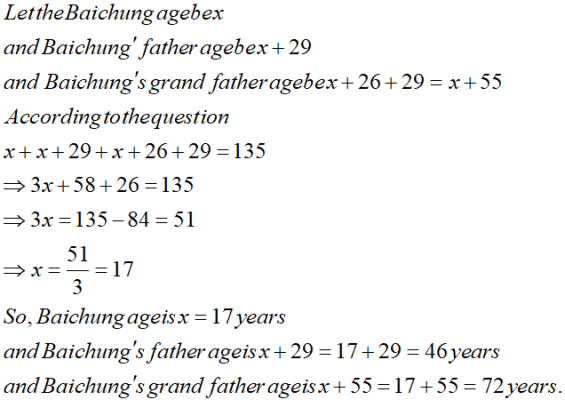Class 8 Maths Linear Equations in One Variable Exercise 2.2
- NCERT Class 8 Maths Linear Equations in One Variable Exercise 2.1
- NCERT Class 8 Maths Linear Equations in One Variable Exercise 2.2
- NCERT Class 8 Maths Linear Equations in One Variable Exercise 2.3
- NCERT Class 8 Maths Linear Equations in One Variable Exercise 2.4
- NCERT Class 8 Maths Linear Equations in One Variable Exercise 2.5
- NCERT Class 8 Maths Linear Equations in One Variable Exercise 2.6
Class 8 Maths Linear Equations in One Variable Exercise 2.2
Class 8 Maths Exercise 2.2 (Page-28)

Solution :

Q2. The perimeter of a rectangular swimming pool is 154 m. Its length is 2 m more than twice its breadth. What are the length and the breadth of the pool?
Solution :

Q3.The base of an isosceles triangle is 43 cm. The perimeter of the triangle is 4\frac { 2 }{ 15 } 215 cm. What is the length of either of the remaining equal sides?
Solution :
\(\displaystyle \begin{array}{l}Let\,the\,both\,side\,of\,the\,length\,of\,the\,triangle=z\,cm.\\perimetre\,of\,the\,triangle\,=sum\,of\,the\,three\,sides\,\\\,\,\,\,\,\,\,\,\,\,\,\,\,\,\,\,\,\,\,\,\,\,\,\,\,\,\,\,\,\,\,\,\,\,\,\,\,\,\,\,\,\,\,=\left( {z+z+\frac{4}{3}} \right)\,cm\,=\left( {2z+\frac{4}{3}} \right)\,cm\\there\,for\,\,\,\,\,\,\,\,2z+\frac{4}{3}=4\frac{2}{{15}}\\\Rightarrow \,\,\,\,\,\,\,\,\,\,\,\,\,\,\,\,\,\,\,\,\,\,2z+\frac{4}{3}=\frac{{62}}{{15}}\\\Rightarrow \,\,\,\,\,\,\,\,\,\,\,\,\,\,\,\,\,\,\,\,\,\,\,\,\,\,\,\,\,\,\,2z=\frac{{62}}{{15}}-\frac{4}{3}\\\,\,\,\,\,\,\,\,\,\,\,\,\,\,\,\,\,\,\,\,\,\,\,\,\,\,\,\,\,\,\,\,\\\Rightarrow \,\,\,\,\,\,\,\,\,\,\,\,\,\,\,\,\,\,\,\,\,\,\,\,\,\,\,2z=\frac{{62-20}}{{15}}\\\Rightarrow \,\,\,\,\,\,\,\,\,\,\,\,\,\,\,\,\,\,\,\,\,\,\,\,\,\,\,\,2z=\frac{{42}}{{15}}\\\Rightarrow \,\,\,\,\,\,\,\,\,\,\,\,\,\,\,\,\,\,\,\,\,\,\,\,\,\,\,\,z=\frac{{42}}{{15}}\div 2\\\Rightarrow \,\,\,\,\,\,\,\,\,\,\,\,\,\,\,\,\,\,\,\,\,\,\,\,\,\,\,\,z=\frac{{42}}{{15}}\times \frac{1}{2}\\\Rightarrow \,\,\,\,\,\,\,\,\,\,\,\,\,\,\,\,\,\,\,\,\,\,\,\,\,\,\,\,z=\frac{{21}}{{15}}\\Therefore\,\,\,\,\,\,\,\,\,\,\,\,\,z=\frac{7}{5}=1\frac{2}{5}\\so,the\,required\,length\,of\,equal\,side\,\\=1\frac{2}{5}\,cm.\end{array}\)
Q4.Sum of two numbers be 95. If one exceeds the other by 15, find the numbers.
Solution :
\(\displaystyle \begin{array}{l}Let\,the\,first\,number\,be\,z\\\text{Second}\,number=z+15\\According\,to\,the\,question,We\,get\\z+\left( {z+15} \right)=95\\\Rightarrow z+z+15=95\\\Rightarrow 2z+15=95\\\Rightarrow 2z=95-15\\\Rightarrow 2z=80\\\Rightarrow z=\frac{{80}}{2}\\\Rightarrow z=40\\\text{Since}\,:s\text{econd}\,number=z+15\\\,\,\,\,\,\,\,\,\,\,\,\,\,\,\,\,\,\,\,\,\,\,\,\,\,\,\,\,\,\,\,\,\,\,\,\,\,\,\,\,\,\,\,\,\,\,\,=40+15=55\\\end{array}\)
Q5.Two numbers are in the ratio 5 : 3. If they differ by 18, what are the numbers?
Solution :
\(\displaystyle \begin{array}{l}Let\,the\,numbers\,are\,5z\,and\,3z.\\According\,to\,the\,question\\5z-3z=18\\\Rightarrow 2z=18\\\Rightarrow z=\frac{{18}}{2}=9\\So,requried\,number\,are\,5z=5\times 9=45\\\,\,\,\,\,\,\,\,\,\,\,\,\,\,\,\,\,\,\,\,\,\,\,\,\,\,\,\,\,\,\,\,\,\,\,\,\,\,\,\,\,\,and\,3z=3\times 9=27.\end{array}\)
Q6. Three consecutive integers add up to 51. What are these integers?
Solution :
\(\displaystyle \begin{array}{l}Let\,the\,first\,number\,is\,x\\so\,\text{consecutive}\,\text{integers}\,\text{be}\,x,x+1\,and\,x+2\\According\,to\,the\,question,we\,get\\x+(x+1)+(x+2)=51\\\Rightarrow x+x+1+x+2=51\\\Rightarrow 3x+3=51\\\Rightarrow 3x=51-3\\\Rightarrow 3x=48\\\Rightarrow x=\frac{{48}}{3}=16\\therefor\,requied\,\text{intergers}\,are\\x,(x+1)\,and\,(x+2)\\=16,16+1\,and\,16+2\\=16,17\,and\,18.\end{array}\)
Q7. The sum of three consecutive multiples of 8 is 888. Find the multiples.
Solution :
\(\displaystyle \begin{array}{l}Let\,the\,first\,number\,is\,8x\\so\,\text{consecutive}\,numbe\text{rs}\,\text{be}\,8x,8(x+1)\,and\,8(x+2)\\According\,to\,the\,question,we\,get\\8x+8(x+1)+8(x+2)=888\\\Rightarrow 8x+8x+8+8x+16=888\\\Rightarrow 24x+24=888\\\Rightarrow 24x=888-24=864\\\Rightarrow x=\frac{{864}}{{24}}=36\\therefore\,required\,\text{integers}\,are\\8x,8(x+1)\,and8(\,x+2)\\=8\times 36,8(36+1)\,and\,8(36+2)\\=288,8\times 37\,and\,8\times 38\\=288,296\,and\,304.\end{array}\)
Q8.Three consecutive integers are such that when they are taken in increasing order and multiplied by 2, 3, and 4 respectively, they add up to 74. Find these numbers.
Solution :
\(\displaystyle \begin{array}{l}Let\,the\,first\,number\,is\,x\\so\,\text{consecutive}\,\text{integers}\,\text{be}\,x,x+1\,and\,x+2\\According\,to\,the\,question,we\,get\\2x+3(x+1)+4(x+2)=74\\\Rightarrow 2x+3x+3+4x+8=74\\\Rightarrow 9x+11=74\\\Rightarrow 9x=74-11\\\Rightarrow 9x=63\\\Rightarrow x=\frac{{63}}{9}=7\\therefor\,requied\,\text{intergers}\,are\\x,(x+1)\,and\,(x+2)\\=7,7+1\,and\,7+2\\=7,8\,and\,9.\end{array}\)
Class 8 Maths Linear Equations in One Variable Exercise 2.2
Class 8 Maths Exercise 2.1 (Page-28)
Q9. The ages of Rahul and Haroon are in the ratio 5 : 7. Four years later the sum of their ages will be 56 years. What are their present ages?
Solution :

Q10. The number of boys and girls in a class are in the ratio 7 : 5. The number of boys is 8 more than the numbers of girls. What is the total class strength?
Solution :
\(\displaystyle \begin{array}{l}Let\,the\,numbers\,of\,boys\,and\,girls\,are\,7x\,and\,5x\,\\According\,to\,the\,question\,\\5x+8=7x\\\Rightarrow 5x-7x=-8\\\Rightarrow -2x=-8\\\Rightarrow x=\frac{{-8}}{{-2}}=\frac{8}{2}=4\\so\,strength\,of\,the\,class\,is\,7x+5x\\=(7\times 4)+(5\times 4)=28+20\\=48\end{array}\)
Q11. Baichung’s father is 26 years younger than Baichung’s grandfather and 29 years older than Baichung. The sum of the ages of all the three is 135 years. What is the age of each one of them?
Solution :

Q12. Fifteen years from now Ravi’s age will be four times his present age. What is Ravi’s present age?
Solution : \(\displaystyle \begin{array}{l}If\,the\,present\,age\,of\,ravi\,is\,x\,years\,\\Then\,after\,15\,years\,will\,be\,(x+15)\,years\\According\,to\,the\,question\,\\x+15=4x\\\Rightarrow x-4x=-15\\\Rightarrow -3x=-15\\\Rightarrow x=\frac{{-15}}{{-3}}=5\\So,present\,age\,of\,ravi\,is\,x=5\,years.\end{array}\)
Q13.A rational number is such that when you multiply it by 52 and add 23 to the product, you get −712. What is the number?
Solution :
\(\displaystyle \begin{array}{l}Let\,the\,rational\,number\,be\,x\\According\,to\,the\,question\,\\x\times \frac{5}{2}+\frac{2}{3}=\frac{{-7}}{{12}}\\\Rightarrow \,\,\,\frac{5}{2}x+\frac{2}{3}=\frac{{-7}}{{12}}\\\Rightarrow \frac{5}{2}x=\frac{{-7}}{{12}}-\frac{2}{3}\\\Rightarrow \,\frac{5}{2}x=-\left( {\frac{7}{{12}}+\frac{2}{3}} \right)\\\Rightarrow \frac{5}{2}x=-\left( {\frac{{7+8}}{{12}}} \right)=-\frac{{15}}{{12}}\\\Rightarrow \frac{5}{2}x=-\frac{5}{4}\\\Rightarrow x=-\frac{5}{4}\times \frac{2}{5}=-\frac{1}{2}\\\Rightarrow x=-\frac{1}{2}\\So,\,requiered\,Rational\,number\,is\,x=-\frac{1}{2}\end{array}\)
Q14.Lakshmi is a cashier in a bank. She has currency notes of denominations ₹ 100, ₹ 50 and ₹ 10, respectively. The ratio of these notes is 2 : 3 : 5. The total cash with Lakshmi is ₹ 4,00,000. How many notes of each denomination does she have?
Solution :
Let the number of ₹100,₹50 and ₹10 notes are\(\displaystyle \begin{array}{l}2x,3x\,and\,5x.\\converyion\,all\,the\,\text{denominations}\,\text{into}\,rupees,we\,have\\2x\times 100,3x\times 50\,and\,5x\times 10\\=200x,150x\,and\,50x\\According\,to\,the\,question,we\,have\\200x+150x+50x=4,00,000\\\Rightarrow 400x=4,00,000\\\Rightarrow x=\frac{{4,00,000}}{{400}}=1000\\\Rightarrow x=1000\\Total\,required\,number\,of\,notes\end{array}\)\(\displaystyle \begin{array}{l}\Rightarrow 400x=4,00,000\\\Rightarrow x=\frac{{4,00,000}}{{400}}=1000\\\Rightarrow x=1000\\Total\,required\,number\,of\,notes\\100\,notes=2\times 1000=2000\\50\,notes=3\times 1000=3000\\and\,10\,notes=5\times 1000=5000\end{array}\)
Q15. I have a total Rs.300/- in coins of denomination Rs.1, Rs.2 and Rs.5. The number of Rs.2 coins is 3 times the number of coins of Rs.5. The total number of coins is 160. How many coins of each denomination ?
Solution :

Q16. The organizers of an essay competition decide that a winner in the competition gets a prize of Rs.100/- and a participant who does not win gets a prize of Rs.25. The total prize money distributed is Rs.3000. Find the number of winners, if the total number of participants is 63.
Solution :

- NCERT Class 8 Maths Linear Equations in One Variable Exercise 2.1
- NCERT Class 8 Maths Linear Equations in One Variable Exercise 2.2
- NCERT Class 8 Maths Linear Equations in One Variable Exercise 2.3
- NCERT Class 8 Maths Linear Equations in One Variable Exercise 2.4
- NCERT Class 8 Maths Linear Equations in One Variable Exercise 2.5
- NCERT Class 8 Maths Linear Equations in One Variable Exercise 2.6
